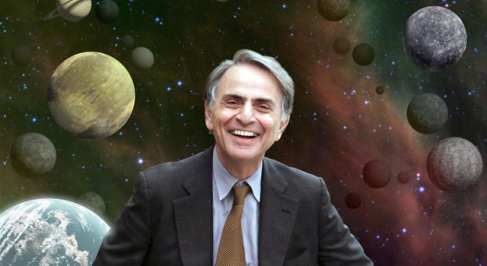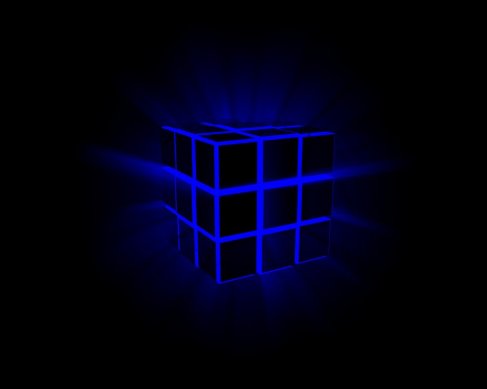
Carl Sagan was one of the most inspirational people ever to live. He was a true hero, he will be remembered throughout history for the great thinker that he was, with the ability to bring passion into millions of lives. He saw things humanity has yet to see, even though he died more than a decade and a half ago his vision will forever guide us.
He has this amazing love for humanity that manifests itself in his speaking. Always so optimistic about humanity, believing that one day we could change, get our act together, love each other and voyage to the stars. We are persistently letting him down, yet we need more people like him, with belief in our humble species. Sadly Sagan’s vision will probably never become reality because people who attain power are only interested in greed, superstition, stupidity and short-term profit, completely ignoring the actual “right” action concerning the entire human race.
A sad coincidence is that it has been mostly since Sagan’s death that we’ve lost all widespread wonder and awe at the possibility of space exploration, it would have saddened Sagan too see us placing more awe and wonder in celebrity gossip and the likes rather than explore the cosmos that we inhabit and are forever confined within.
General Information: Born on Nov 9 1934 Carl Sagan was an astronomer, astrophysicist, cosmologist, author, science populizer and communicator. Most of his career was spent at Cornell University directing the Planetary Stuides Laboratory. He is well known for his popular science books and his award-winning 1980’s television series “Cosmos”. Sagan has many scientific achievements/discoveries to do with the planets in the Solar System, some of his most notable research is on the possibilites of extraterrestrial life. He demonstrated the production of amino acids from basic chemical radiation. His trademark was to simultaneously emphasize the value and worthiness of the human race while at the same emphasizing the relative insignificance of the Earth and humanity in comparison to the universe.
Sagan believed that the Drake equation, on substitution of reasonable estimates, suggested that a large number of extraterrestrial civilizations would form, but that the lack of evidence of such civilizations highlighted by the Fermi paradox suggests technological civilizations tend to self-destruct. This stimulated his interest in identifying and publicizing ways that humanity could destroy itself, with the hope of avoiding such a cataclysm and eventually becoming a spacefaring species
Some of his best, most inspirational quotes:
If you wish to make an apple pie from scratch, you must first invent the universe.
Human history can be viewed as a slowly dawning awareness that we are members of a larger group.
A tiny blue dot set in a sunbeam. Here it is. That’s where we live. That’s home. We humans are one species and this is our world. It is our responsibility to cherish it. Of all the worlds in our solar system, the only one so far as we know, graced by life.
Every one of us is, in the cosmic perspective, precious. If a human disagrees with you, let him live. In a hundred billion galaxies, you will not find another.
As the ancient myth makers knew, we are children equally of the earth and the sky.
Human beings have a demonstrated talent for self-deception when their emotions are stirred.
The surface of the earth is the shore of the cosmic ocean. … Recently, we’ve managed to wade a little way out, maybe ankle-deep, and the water seems inviting.
The beauty of a living thing is not the atoms that go into it, but the way those atoms are put together. Information distilled over 4 billion years of biological evolution. Incidentally, all the organisms on the Earth are made essentially of that stuff. An eyedropper full of that liquid could be used to make a caterpillar or a petunia if only we knew how to put the components together.
There can be an infinite number of polygons, but only five regular solids.
The sky calls to us. If we do not destroy ourselves, we will one day venture to the stars.
Our loyalties are to the species and the planet. We speak for Earth. Our obligation to survive and flourish is owed not just to ourselves, but also to that Cosmos, ancient and vast, from which we spring.
Consider again that dot. That’s here. That’s home. That’s us. On it everyone you love, everyone you know, everyone you ever heard of, every human being who ever was, lived out their lives. The aggregate of our joy and suffering, thousands of confident religions, ideologies, and economic doctrines, every hunter and forager, every hero and coward, every creator and destroyer of civilization, every king and peasant, every young couple in love, every mother and father, hopeful child, inventor and explorer, every teacher of morals, every corrupt politician, every “superstar”, every “supreme leader”, every saint and sinner in the history of our species lived there – on a mote of dust suspended in a sunbeam.
Our posturings, our imagined self-importance, the delusion that we have some privileged position in the Universe, are challenged by this point of pale light. Our planet is a lonely speck in the great enveloping cosmic dark. In our obscurity, in all this vastness, there is no hint that help will come from elsewhere to save us from ourselves.
Once we overcome our fear of being tiny, we find ourselves on the threshold of a vast and awesome Universe that utterly dwarfs — in time, in space, and in potential — the tidy anthropocentric proscenium of our ancestors.
The vast distances that separate the stars are providential. Beings and worlds are quarantined from one another. The quarantine is lifted only for those with sufficient self-knowledge and judgement to have safely traveled from star to star.
I worry that, especially as the Millennium edges nearer, pseudo-science and superstition will seem year by year more tempting, the siren song of unreason more sonorous and attractive.
Absence of evidence is not evidence of absence.
Take care,
Mete.
Symphony of Science (these are amazing):
http://www.youtube.com/watch?v=zSgiXGELjbc
http://www.youtube.com/watch?v=XGK84Poeynk
http://www.youtube.com/watch?v=vioZf4TjoUI
The Cosmos (Complete Series):
http://www.youtube.com/watch?v=Pa1ImgOcOPM
You can reach the other episodes from related links next to this one. This is the first.
Links to read about SAGAN:
http://www.notablebiographies.com/Ro-Sc/Sagan-Carl.html#b
http://www.planetary.org/about/our-founders/carl-sagan.html


